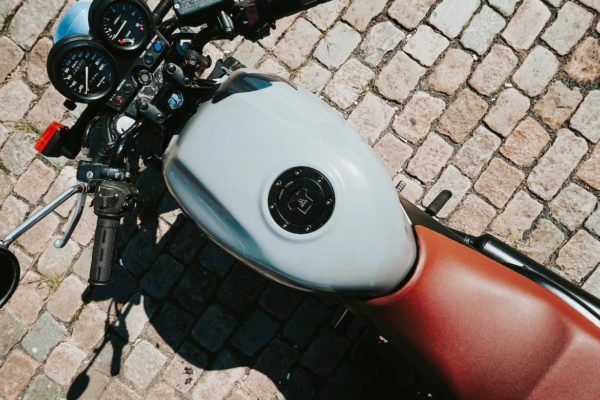Winterizing the motorbike can be the only solution for saving it when stringing it in winters; now the question arises, what to put in a motorcycle gas tank for winter?
When winterizing the motorbike for the winters, you should add antifreeze fluid to your motorbike gas tank to protect the ice crystal formation, which can burst the gas tank and gas pipes. Make sure that the antifreeze liquid is fully concentrated and doesn’t contain traces of water in it.
Let’s consider what it means and what you can do about it.
While writing this post, I leave no stone unturned so you can know everything about what to put in a motorcycle gas tank.
Table of Contents
What to Put in a Motorcycle Gas Tank for Winter?
Indeed you can protect your motorbike tires, chain, and wires, including eclectic wires and batteries, by storing the motorbike in the winter properly. But for protecting your motorcycle from the ice crystal formation, you need something to add.
When winterizing the motorbike for the winters, you should add antifreeze fluid to your motorbike gas tank to protect the ice crystal formation, which can burst the gas tank and gas pipes.
With the antifreeze liquid, you can be reassured that there won’t be ice crystals forming in your motorbike gas tank.
Can You Put any Antifreeze Fluid on a Motorcycle Gas Tank for Winter?
So far, you understand that you need to add antifreeze fluid to your motorbike to protect your motorbike gas tank from the attack of ice crystal formation. Now the question arises, can you put any antifreeze fluid in your motorbike gas tank?
You can’t add any antifreeze liquid to your motorbike gas tank for the winter; you need to be sure that the motorbike antifreeze should be fully concentrated and doesn’t contain any trace of water.
A small trace of water makes antifreeze liquid useless and leads to ice crystal formation in your motorbike gas tank.
How Does Winterization Work for Your Motorbike?
Winterization is an essential process, especially if you don’t plan to ride your motorbike during the winter season. Let’s explore how winterization helps protect your motorbike.
The first step in winterization is storing your motorbike in a garage or a suitable storage space for the entire winter period when you don’t intend to ride it. During this time, it is recommended to remove the tires, as they can flatten or deteriorate when not in use. This helps preserve the quality and lifespan of the tires.
Another crucial aspect of winterization is addressing the fuel in your motorbike’s gas tank. Motorbike fuel often contains ethanol, which can absorb moisture from the surrounding environment during the winter months. This moisture can lead to rust and corrosion within the gas tank. To prevent this, it is important to remove all traces of fuel containing ethanol and replace it with a fuel stabilizer or drain the tank completely.
Additionally, it is advisable to remove the battery from your motorbike during winterization. This prevents any potential drain or damage to the battery over an extended period of inactivity. Storing the battery in a cool and dry place and periodically charging it can help maintain its longevity.
How Does Winterization Protect Your Gas Tank?
By following these winterization steps, you protect your motorbike from various side effects of winter. It ensures that your tires remain in good condition, prevents the formation of ice crystals in the gas tank, and safeguards the engine from corrosion caused by ethanol or rust.
Proper winterization helps maintain the overall health and performance of your motorbike, ensuring that it is ready for use when the riding season resumes.
Should You Empty Your Motorbike Gas Tank in Winter?
Indeed you should use a motorbike antifreeze fluid that doesn’t contain any trace of water so that no ice crystal formation would be possible in the motorbike gas tank. Now, should you empty your motorbike gas tank in winter?
Emptying the motorbike tank could be the only solution you’re seeing to avoid any ice crystal formation in your motorbike gas tank. But even after emptying the motorbike gas tank, you can’t be reassured that no ethanol trace is still there in your motorbike gas tank.
Even a small trace of ethanol can cause ice crystal formation in the motorbike gas tank and gas pipes. It’s better to fill your motorbike gas tank with 90% fuel and fill the rest of the motorbike gas tank with the antifreeze fluid.
With this step, you can protect your motorbike gas tank from expandable ice crystal formations.
What if You Don’t Put Antifreeze Fluid on a Motorcycle Gas Tank?
So far, you understand that you shouldn’t empty the motorbike gas tank,
Indeed you can fill 10% antifreeze fluid in it; now the question arises, what if you don’t put antifreeze fluid in a motorcycle gas tank?
In the subzero temperature around your motorbike, the significant traces of ethanol in the motorbike gas tank starts to freeze, making small ice crystals. Initially, there won’t be any problems related to motorbike gas tanks. Still, the significant growth of ice crystals in the motorbike gas tanks starts to expand after some time.
While expanding, the gasoline in the motorbike starts to push the gas tank wall outwards, leading cause the thinning wall of the gas tank. Your motorbike gas tank might survive this expanding process. Still, unfortunately, motorbike gas pipes won’t survive the expanding cause them to leak.
And that’s why experts recommend adding 10% antifreeze fluid to the motorbike gas tank.
How Can Antifreeze Save Your Motorcycle Gas Tank?
Indeed your motorbike gas tank and pipes have to pay a huge price if you don’t add antifreeze to the motorbike gas tank. Now the question arises, how can antifreeze save your motorbike gas tank?
Antifreeze is a fluid like other motorbike fluids. Still, it has a high density and mass, which makes the antifreeze settle below the motorbike gas tank. While settling in the gas tank, they start to absorb traces of moisture and increase the low temperature withstanding capacity of the motorbike gas.
However, you need to ensure that you’re adding only concentrated motorbike antifreeze to increase the fuel-withstanding capacity.
Should You Add Antifreeze Before or After Filling the Motorbike Gas Tank?
So far, you understand the working of antifreeze in simpler words and how it prevents the motorbike gas tank from ice crystals; now the question arises, should you add antifreeze before or after filling the motorbike gas tank?
According to experts, it doesn’t matter whether you add the antifreeze liquid before or after filling the motorbike gas tank. The antifreeze works the same in either way.
Some riders preferred to add antifreeze after filling the motorbike gas tank to boost the mixability of both fluids.
Can Antifreeze Protect Motorcycle Gas Tanks from Rusting?
Indeed the antifreeze settles below in the motorbike gas tank and protects the motorbike gas tank from the ice crystals. Now the question arises, can antifreeze protect your motorbike gas tank from rusting?
The antifreeze protects your motorbike gas tank from forming ice crystals by settling below the gas tank and absorbing the trace of water in the fuel.
Rust and corrosion need traces of water and air. By absorbing the fuel tank’s moisture content, antifreeze protects the motorbike gas tank from ice crystal formation, rust, and corrosion.
So one fluid can protect your motorbike gas tank from two problems simultaneously.
Also, read my previous post where I discussed whether you leave your motorbike in the rain, CLICK HERE to read.
Frequently Asked Questions:
Can you put the antifreeze liquid in the motorbike gas tank?
You can’t add any antifreeze liquid to your motorbike gas tank for the winter; you need to be sure that the motorbike antifreeze should be fully concentrated and doesn’t contain any trace of water.
How does winterization work for your motorbike?
If you fail to winterize your motorbike, the tires may lose air pressure and become ineffective, rendering them useless. Additionally, the gas pipes of your motorbike are at risk of exploding due to the formation of ice crystals, leading to potential damage. It is crucial to address these issues to prevent any mishaps.
How does winterization protect your motorbike gas tank?
Motorbike gas often contains ethanol, which has a tendency to absorb moisture from the surrounding environment during winter. This moisture absorption can lead to the development of rust inside the motorbike gas tank. To prevent corrosion and ensure the longevity of your gas tank, experts strongly advise eliminating all traces of ethanol-containing fuels. By taking this precautionary step, you can avoid any potential damage caused by rust in the gas tank.
Should you empty the motorbike before storing the motorbike?
It’s not always enough to simply empty your motorbike’s gas tank to ensure that all traces of ethanol have been removed. Even the smallest amounts of ethanol can remain and cause ice crystal formation in the gas pipes of your motorbike’s tank. To prevent this, it’s recommended that you instead fill your tank with a combination of 90% fuel and antifreeze fluid to ensure the ethanol is fully diluted and won’t cause any issues.
What if you don’t put the antifreeze in your motorbike gas tank?
In the subzero temperature around your motorbike, the significant traces of ethanol in the motorbike gas tank starts to freeze, making small ice crystals. Initially, there won’t be any problems related to motorbike gas tanks.
Final Verdict:
What to put in a motorcycle gas tank for winter? When winterizing the motorbike for the winters, you should add antifreeze fluid to your motorbike gas tank to protect the ice crystal formation, which can burst the gas tank and gas pipes.
Make sure that the antifreeze liquid is fully concentrated and doesn’t contain traces of water in it. I’ve also mentioned the working principle of antifreeze and how it protects your motorbike from rust and ice crystals.
John, this side! My passion for motorbikes started when I was 12. I experienced many accidents and even lost some friends too. And it inspired me to create this website so that no parents in this world would lose their child while enjoying riding.


